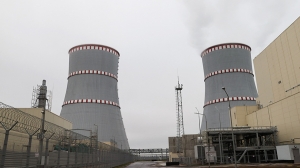BelNPP's first unit generates 1.8bn kWh of electricity

MINSK, 5 April (BelTA) – The first power unit of the Belarusian nuclear power plant (BelNPP) has generated 1.8 billion kWh of electricity since its connection to the country's power grid, Belarus' Energy Minister Viktor Karankevich said in an interview to Belarus 1 TV channel, BelTA has learned.
“Some 1.800 billion kWh has been produced since the commissioning of the first unit and its connection to the Belarusian power system. The unit is currently at the stage of pilot operation, during which the appropriate tests and routine work are being carried out. The total number of tests performed is 309 out of 394. When all the tests are successfully completed, we will move on to comprehensive testing of the unit. This means operation at nominal power of the reactor unit for 15 days,” said Viktor Karankevich.
The overall readiness of the second unit is 80%. “This year the reactor has already been assembled and the simulated fuel assemblies have been loaded into it. In the near future, we plan to move on to the next sub-stage, the so-called cold and hot running-in of the reactor unit. Deliveries of fresh nuclear fuel to the second reactor and its loading into the reactor core are also planned for 2021,” the minister said.
As for the integration of the BelNPP into the power grid, Viktor Karankevich said that all the projects on construction of electric boilers with their total capacity of 916 MW were finished in 2020. They were already involved in the production of energy for heating large communities during the 2021 heating season. “This was done during the pilot operation of the first unit of the nuclear power plant,” he stressed.
The next stage of the BelNPP integration into the country's power grid will be the construction of peaking and reserve sources. They will be installed at the Bereza and Lukoml hydroelectric power plants, the Novopolotsk CHP plant, and Minsk CHP plant No.5.
Special attention is paid to the modernization of the electric power infrastructure. Some 1,900km of power lines of various voltage classes were built and upgraded in 2020. The target is to reach the annual construction of 2,700km of power grids starting from 2022. This include the construction, replacement, reconstruction and modernization of power grids.
The Belarusian nuclear power plant is expected to help the country increase its energy security and reduce dependence on hydrocarbon fuel, the minister added. According to him, this is a priority task for the country's energy complex, which is included in the government's program through 2025. With the commissioning of the nuclear power plant, greenhouse gas emissions into the atmosphere will be reduced by 7 million tonnes.
According to Viktor Karankevich, the volume of electricity consumption in the country will increase to 44 billion kWh by 2025. In 2020, this figure was 38 billion kWh. In his words, such forecasts are related, first of all, to an increase in energy consumption by the real sector of the economy, taking into account the implementation of investment projects to build new production facilities or modernize existing ones. It is expected that the implementation of measures included in the inter-industry complex of measures to increase electricity consumption through 2025, approved by the government, will provide an increase in electricity consumption to 2.7 billion kWh per year.
Earlier this year, the Energy Ministry of Belarus approved a comprehensive program to increase the use of electricity for heating and hot water supply purposes. “Through the modernization of electrical networks, construction of new and modernization of existing substations, as well as improvement of the legal framework, we plan to reach an increase in electricity consumption in the area up to 900 million kWh by 2025,” the minister said.
Another direction is the use of electricity for heat production by electric boilers. In 2019-2020, electric boilers with a total capacity of 836 MW were put into operation at 19 power facilities of the country.
The consumption of electric energy by other sectors of the economy is also expected to increase, taking into account the projected GDP growth, Viktor Karankevich concluded.













